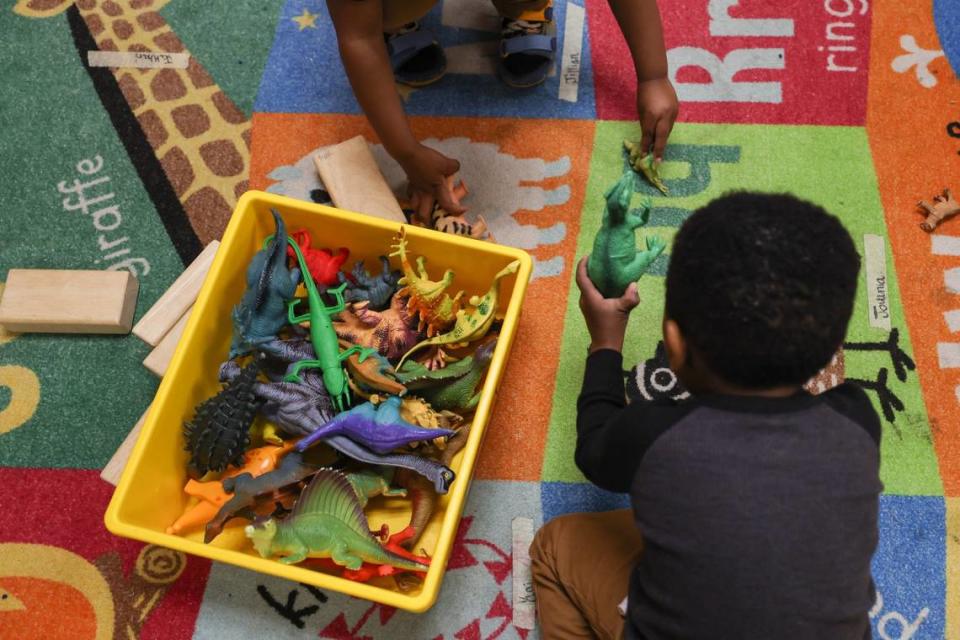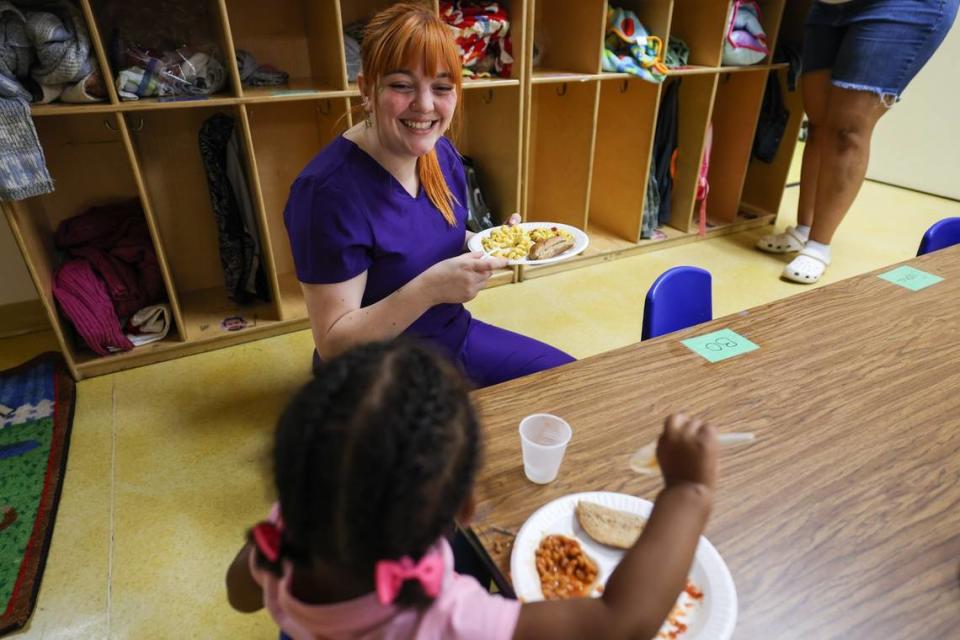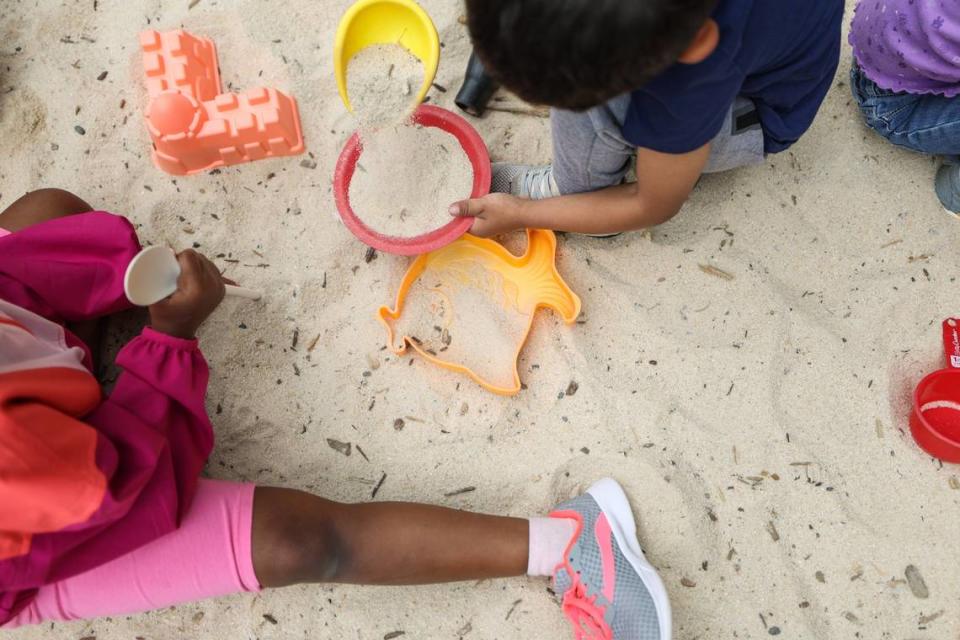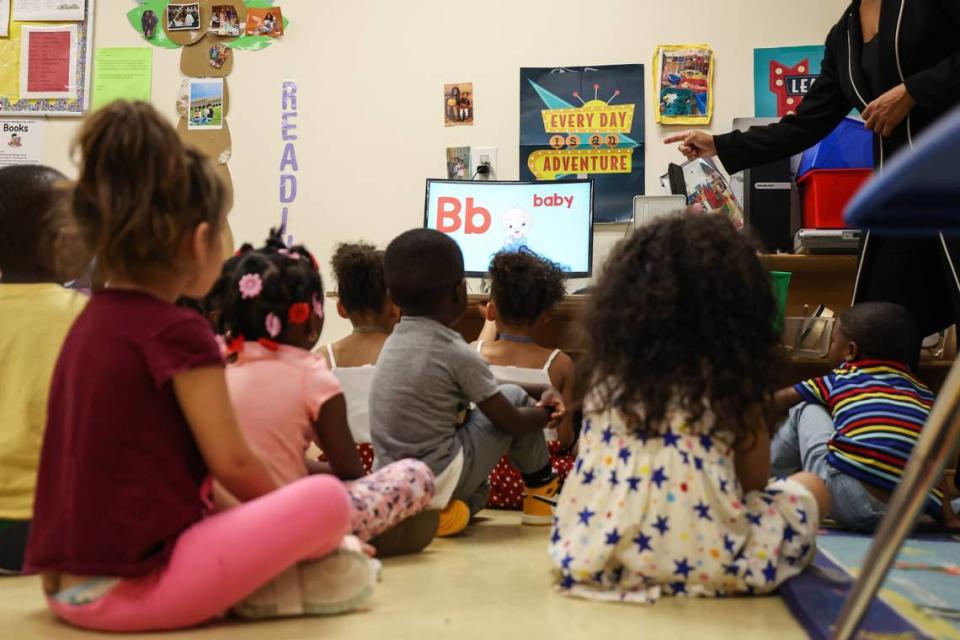NC child care industry in crisis: prices too high for parents and pay too low for staff
Peace of mind came with a hefty price and a monthslong wait for Kimberlin Cox.
Cox had no choice once the pandemic eased and she needed to return to work in person — she had to find day care for her toddler. Most places told her it would be a three-to-six-month wait. She was lucky, though. Her mom, who lives nearby and is retired, watched Cox’s daughter during the waiting period.
Now having finally secured a spot, the cost is about $1,500 a month — enough to rent an apartment in Charlotte.
“It’s hard to find a reliable day care that you can trust with your children,” Cox, a Steele Creek resident who works in accounting, told The Charlotte Observer. “I wanted a safe, clean environment that had a good learning structure, and they did more than just babysat my child. I was lucky. However I feel like it comes at a price.”
She’s not alone.

Child care advocates across North Carolina call it a quagmire: parents struggle to find and afford child care while providers wrestle with staying open and finding teachers. It’ll get worse, advocates say, unless lawmakers agree on the solution: investing more money in young children.
“Child care in the Charlotte region and across our entire state is really at a critical flashpoint,” said Janet Singerman, president and chief executive officer of Child Care Resources Inc that serves Mecklenburg, Cabarrus, Union, Rowan and Stanly counties. “Here’s the Catch-22 of child care: parents can’t afford to pay more, teachers can’t afford to earn less and child care programs can’t charge more if they want to stay in business.”
Child Care Resources Inc. is a primary source of continuing education, training and coaching for operators and teachers. It helps families choose programs and navigate the system — one that Jenna Nelson of the NC Early Education Coalition says is not receiving enough state funding to keep up with needs.
“Early education makes up just 1% of North Carolina’s state budget. Just 1%. We are asking our state legislators to double that investment,” Nelson said.
Singerman says the crisis keeps her up at night.
“What happens to children, families, employers, and our economy when child care programs cannot operate because they cannot keep or hire staff?” she said.
The pandemic effect

Singerman says the COVID-19 pandemic revealed child care as “the workforce behind the workforce.” It was essential to employers, parents and the economy.
“But it also exposed the inadequate and fragile economic equation within which child care programs must operate,” Singerman said.
The industry suffered reduced enrollment and increased operating and staffing costs, but there were still children to look after.
“Our child care system never shut down,” Singerman said. “While many employees left their workplaces, child care employees stayed, risking their own health and well-being to provide continued access to safe, quality child care – making it possible for other parents to work.”
Without more help, operators say they will lose staff, it’ll be harder to recruit and retain experienced and educated workers, program quality will suffer and parents will likely face increased child care costs — and may leave their jobs as a result.
“The issue is real, and the need is urgent,” Singerman said. “Without significant investment, the child care landscape could look like it did 40 years ago in Charlotte when child care was hard to find, and quality child care was even more scarce.”
Living in a child care desert
North Carolina has one of the highest rates in the U.S. of working mothers with young children, and more than 220,000 children spend part or all of their day in regulated child care arrangements, according to the state Division of Child Development and Early Education. That often means children are in licensed care instead of being watched by family members.
In Mecklenburg County, 66% of children under 6 live in households with all parents working, which mirrors the state trend. In Mecklenburg County, there are also 4.2 children per licensed child care spot. And in North Carolina, 44% of all residents live in a child care desert, Nelson says. A region is considered a desert when there are more than three times as many children as licensed child care slots.

Carrie Davis and her husband, Michael, live in Davidson and are parents to three young children, including twins. Until a year ago, both worked full-time jobs. When their first child was born in September 2016, the parents waited about eight months to get a spot in an infant day care room.
“When we found out we were having fraternal twins in January 2018, we immediately did two things: purchased a minivan and notified our day care center we’d need two spots in the infant room come fall,” Carrie Davis said. “We already had our eldest at the center so we were immediately put to the top of the list.”
But that still meant their twins, born in August 2018, didn’t have open spots until June 2019.
During both waits for day care spots, the Davis’ were forced to hire nannies.
The cost problem
After years of trying to balance parenting and her career, Davis decided to step away from full-time work last year. And child care prices played a role. The Davis family paid as much in child care as some people earn in a year.
“To this day, the most surprising thing is the sheer price of day care in this area,” she said. “It’s astronomical. It’s still astonishing to me that we paid more than $40,000 for child care and the math worked out where it still made financial sense for me to continue working. Thankfully, nearly all our child care providers were worth their weight in gold.”
The average cost of child care for a baby in North Carolina is $9,480 per year. In Mecklenburg County, the average cost is slightly higher — $9,893 per year. But that range can vary by thousands of dollars depending on the center’s rating. For a 1-year-old in a child care center, the cost can range from $13,653 per year at a 3-star center to $15,895 per year at a 5-star center.
“My husband and I pay well over our mortgage for our two children,” Nelson said. “We’ll end up spending way more than what we’ll spend when they go to college.”
Singerman says the first five years of child care on average in Mecklenburg costs $65,468 — more than the cost of tuition for four years at UNC Charlotte or UNC-Chapel Hill.
Not enough child care centers

A big part of the problem: child care services are not keeping up with demand. Licensed child care programs for infants and toddlers, for example, can only serve 18.7% of the infant-toddler population across the state, Singerman and Nelson say.
In Mecklenburg County, there are about 557 child care sites, which include private or community programs, public school programs, family child care homes and churches. There are nearly 26,000 children enrolled in child care centers and 4,853 average staff members working per month, based on the state’s dashboard.
In 2021-22, a study funded by the NC Early Education Coalition estimated there were 42,066 infants, 1-year-old and 2-year-old children alone in Mecklenburg County.
Since the height of the pandemic, enrollment in Mecklenburg County child care programs has increased by the hundreds. Yet, enrollment hasn’t yet reached pre-pandemic numbers — when nearly 4,000 2-year-olds were enrolled in child care programs. That dipped to 2,341 during the COVID-19 pandemic and climbed to 2,669 in 2021-22.
Still, Nancy Ridgeway, owner of Lollipop Child Development Center in Charlotte, told the Observer she has an ever-growing wait list.
“There are probably 80 or so families that need care,” Ridgeway said, “and are hoping to get a call soon that we can help them out.”
Pleas for state help
During the pandemic, the federal government boosted child care in a big way through stabilization grants: it quadrupled its annual investment in the state’s child care system from $333 million to $1.3 billion. That money went toward things such as raises for staff and hiring and retaining the staff necessary to stay open during the pandemic.
North Carolina’s Child Care Stabilization Grants pumped more than $106 million into Mecklenburg County for child care programs.
The result: Mecklenburg minimized losses to just 5% of programs, 7% of its spaces and 6% of its child care workforce, Singerman says.
But some grants have already ended and more are scheduled to end in December. State child care advocates say lawmakers adding more state funding to the budget would help provide affordable and accessible child care for families, and better pay and benefits for child care teachers, among others.
It’s not looking good.

Right now, the House budget earmarks $45.8 million in new funding for child care, roughly 15% of the $300 million requested from the chairs of the early childhood caucus to avoid a fiscal cliff — a sudden drop in help. The $300 million would extend the grants given during the pandemic, which Gov. Roy Cooper proposed in his budget.
Nelson said the Senate budget proposal this week was worse: less than 1% of requested money.
“The budget does not include any of the crucial funding or policies proposed,” Nelson said. “With federal relief funding coming to an end soon, (this) budget would continue to put child care on a very precarious path.”
The House’s $45.8 million includes $24 million recurring to keep child care subsidy rates at their current level. If the state doesn’t help, the rate child care providers are paid would go back down to the 2018 market rates — before COVID-induced help.
The Observer contacted several state legislators to ask about child care in North Carolina, including Union County Rep. David Willis, a Republican who co-chairs the early child care caucus and is the owner of a preschool. No lawmakers returned a request for comment, but Willis told EdNC in April that without a proposed $300 million request for child care “we’re going to lose a significant number of child care providers across the state.”
Supports needed for families
Even before the pandemic, child care facilities across the state faced challenges: high demand for care and the rising cost of living. Low compensation and lack of benefits now make it hard to recruit and retain qualified early child educators.
The North Carolina Early Education Coalition estimates child care facility teachers earn an average of $12 per hour, nearly 40% rely on public assistance and they are more than seven times more likely than public kindergarten teachers to live in poverty. About one in five child care teachers don’t have health insurance.
Lollipop Child Development Center in Charlotte, which opened in 1989, has 40 employees. Ridgeway says she’s always looking to hire qualified, experienced and educated teachers who are passionate about impacting children’s lives.
The state’s investment in child care is crucial to staff’s ability to remain employed at a living wage, Ridgeway says. North Carolina’s child care providers used stabilization grants the American Rescue Plan Act funded to stay open during the COVID-19 pandemic.
Ridgeway was able to give raises and bonuses to teachers that would not have been possible without the grants. These teachers, she says, are not flocking to jobs in the industry because of the typical low wages.
“Considering how vital early childhood education is, I wish the state, feds/government agencies would take a more proactive and aggressive approach to funding and creating more opportunities in our country,” Carrie Davis said. “I guess you could add it to the long list of items our country could improve upon, but I wish more than anything there were more supports in place for families, especially those of dual working families.”

